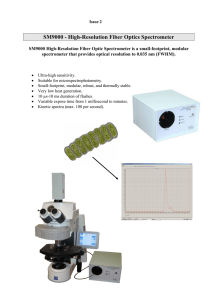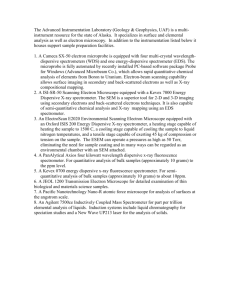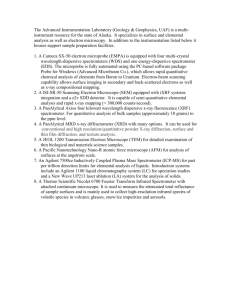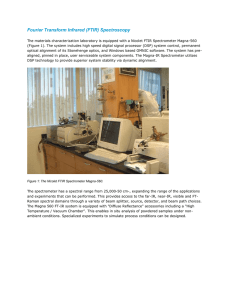Electron energy loss spectroscopy of organic molecules in
advertisement
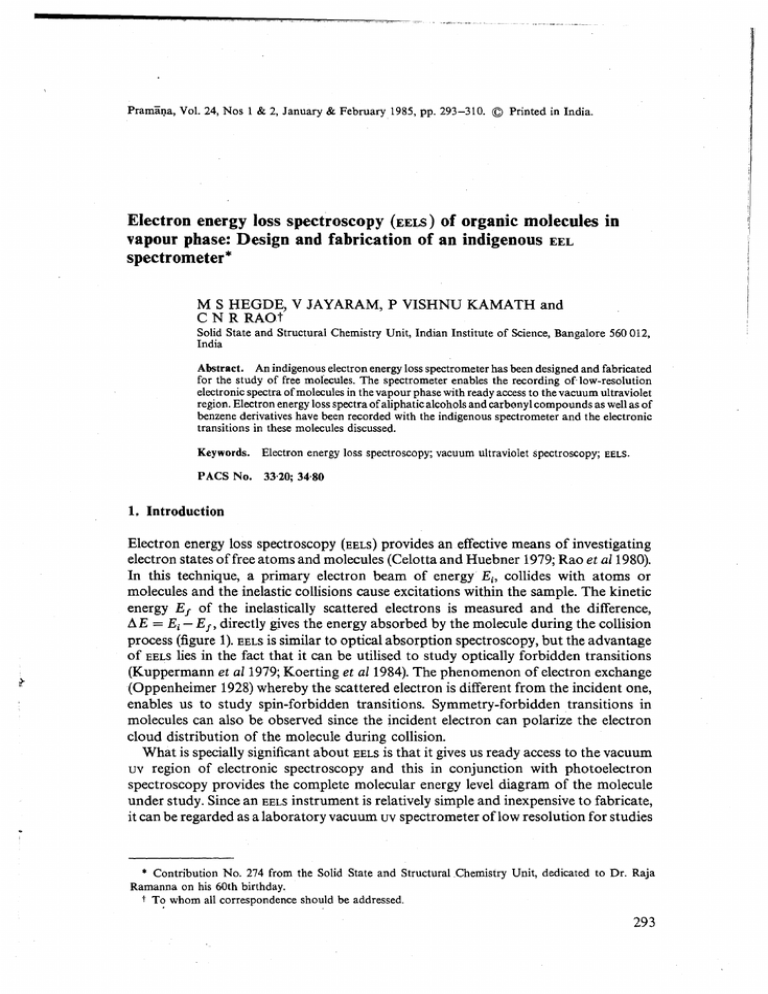
Pramal).a, Vol. 24, Nos 1 & 2, January & February 1985, pp. 293-310. © Printed in India.
Electron energy loss spectroscopy (EELS) of organic molecules in
vapour phase: Design and fabrication of an indigenous EEL
spectrometer*
M S HEGDE, V JAYARAM, P VISHNU KAMATH and
C N R RAOt
Solid State and Structural Chemistry Unit, Indian Institute of Science, Bangalore 560012,
India
Abstract. An indigenous electron energy loss spectrometer has been designed and fabricated
for the study of free molecules. The spectrometer enables the recording of low-resolution
electronic spectra of molecules inthe vapour phase with ready access to the vacuum ultraviolet
region. Electron energy loss spectra of aliphatic alcohols and carbonyl compounds as wellas of
benzene derivatives have been recorded with the indigenous spectrometer and the electronic
transitions in these molecules discussed.
Keywords.
Electron energy loss spectroscopy; vacuum ultraviolet spectroscopy;
P ACS No.
33'20; 34'80
EELS.
1. Introduction
Electron energy loss spectroscopy (EELS) provides an effective means of investigating
electron states of free atoms and molecules (Celotta and Huebner 1979; Rao et aI1980).
In this technique, a primary electron beam of energy E b collides with atoms or
molecules and the inelastic collisions cause excitations within the sample. The kinetic
energy Ef of the inelastically scattered electrons is measured and the difference,
bt.E = E, - Et- directly gives the energy absorbed by the molecule during the collision
process (figure 1). EELS is similar to optical absorption spectroscopy, but the advantage
of EELS lies in the fact that it can be utilised to study optically forbidden transitions
(Kuppermann et al1979; Koerting et aI1984). The phenomenon of electron exchange
(Oppenheimer 1928) whereby the scattered electron is different from the incident one,
enables us to study spin-forbidden transitions. Symmetry-forbidden transitions in
molecules can also be observed since the incident electron can polarize the electron
cloud distribution of the molecule during collision.
What is specially significant about EELS is that it gives us ready access to the vacuum
uv region of electronic spectroscopy and this in conjunction with photoelectron
spectroscopy provides the complete molecular energy level diagram of the molecule
under study. Since an EELS instrument is relatively simple and inexpensive to fabricate,
it can be regarded as a laboratory vacuum uv spectrometer oflow resolution for studies
* Contribution No. 274 from the Solid State and Structural Chemistry Unit, dedicated to Dr. Raja
Ramanna on his 60th birthday.
t T~ whom all correspondence should be addressed.
293
294
M S Hegde et
at
E.
1
6E
• •
M+tZ
(E,)
-
*
M+tZ
I
(E.-ll.E)
I
Figure 1. Schematic illustration of the electron energy loss technique for electronic
excitations.
involving identification and characterization of molecules in the vapour phase. EELS has
the disadvantage of low resolution, a feature common to all techniques of electron
spectroscopy. In this paper we report the design and fabrication of a simple EEL
spectrometer devoted to the study of atoms and molecules in the gas or vapour phase.
We discuss the EEL spectra of several organic molecules recorded with this indigenous
spectrometer, having calibrated the spectrometer with gases such as He, O 2 and N 2 •
2. Design of the spectrometer
The spectrometer consists of an electron beam source, a monochromator, electron
lenses, sample chamber, analyser and a detector. As most of the electronic excitations in
the uv and vacuum uv regions lie in the energy range of 4-1 0 eV, the energy ofa typical
source should be about three to five times this energy. We have therefore selected a
source energy in the range of 30-70 eV. The design criteria for fabrication of the
spectrometer were based on the three important factors discussed below.
2.1 Incident electron beam intensity
As the electron beam passes through each of the components of the spectrometer, there
is a certain loss in intensity. This loss is minimized by the use of appropriate electron
optics; the number of inelastically scattered electrons would also be small, being
typically two orders ofmagnitude lessthan the incident beam. In view of these factors, it
is necessary to have an intense elastic peak ofat least 105 counts/sec at the mouth of the
detector. This would correspond to a current of 10- 14 amps. Assuming a loss in
intensity of the order of 104 in the monochromator, 103 in the sample chamber and a
further loss of lOin the analyser, the total loss over all the components would be of the
order of 10 8 • The electron gun source must therefore be capable ofemitting in the range
of 1-10 microamps in the energy range 30-70 eV. The electron source was designed
with these specifications in view.
EEL
spectrometer
295
2.2 Resolution
The desired resolution of a spectrometer of this kind meant for the study of organic
molecules (operating under low resolution), is approximately 400 meV for a primary
energy of about 50 eV. Resolution of this order can be obtained using spherical sector
analysers (Kuyatt and Simpson 1967). The resolution Ii E IE of spherical sector
analysers is given by the formula IiEIE = S/2R o where S is the slit width and R o is the
mean radius of the analyser. If we use a convenient slit width of 1 mm, an analyser of a
mean diameter of 125 mm is needed.
.
2.3 Vacuum conditions
Since the spectrometer is devoted to the study of atoms or molecules in the gas or the
vapour phase, it is clear that two separate and independent pumping systems are
required. One provides the base vacuum required for monochromator and the
spectrometer chambers, while the other provides differential pumping for the stream of
sample molecules. The sample pressure required to record an EEL spectrum depends on
the nature of the sample, as well as the length of the sample chamber. The sample
pressure must be such that the mean free path of the electrons for electron impact
excitation mustbe less than the length of the collision chamber. The mean free path A is
defined as A = 1Ina, where n is the number of molecules per c.c. and (J is the inelastic
electron impact collision cross-section. Assuming (J to be in the range 10- 1 5-10- 16 em!
(McDaniel 1964)for a Aofapproximately 25 mm, the sample pressure required is of the
order of 10- 4-10- 3 torr. The desired base vacuum of the spectrometer on the other
hand is of the order of 10- 6 torr. Hence the crucial need would be for an effective
differential pumping of the sample. The vacuum system was designed keeping these
requirements in view.
3. Fabrication of the spectrometer
3.1 Electron source
A schematic diagram of the electron gun used in the spectrometer is shown in figure 2. A
thoriated tungsten filamet of 0·1 mm dia is mounted on a pair ofNi rods. The filament is
......
eM.
V F ~"""--f'---------;
e.c
11. F.
Figure 2. Schematicdiagram of the electron gun used in the spectrometer. OC: outercasing;
VF; vacuum feed through; R: reflecting electrode; W: tungstun filament; G: grid; CM:
collimator; MF: main flange.
---~--~
296
M S Hegde et al
resistively heated with a constant current-stabilised power supply fabricated in the
laboratory. The electron beam current is controlled by using a negatively biased grid.
The gun is mounted on a 63 mm diameter brass flange and enclosed in a stainless steel
casing as shown in figure 2. Electrons with energy of 30-70 eV were obtained in this
manner.
When the filament is fitted to a reflecting electrode R, which is at the same voltage as
the filament, an emission current of 5-10 ,uamp can be obtained.
3.2 Monochromator and analyser
The monochromator as well as the analyser consist of two hemispherical sectors of
mean diameter 125 mm. The hemispherical sectors have been machined out of Al
blocks to an accuracy of ± 0·025 mm. The hemispherical sectors are gold-coated by
vacuum deposition employing planetary rotation, to ensure uniform coating of the
spherical surfaces. The sectors are then mounted on a 6 mm thick aluminium support
plate with suitable electrical insulation (figure 3); the electrical insulations are also
shown in the figure.
E
E
N
MF
I
I
I
I
: 25mm I
~
SOURCE
Figure 3. Schematic illustration of the analyser assembly. Shaded areas are machined out of
teflon. IS: inner sphere; as: outer sphere; SP: support plate; MF: main flange. Inset shows the
details of insulation employed in the assembly of the analyser.
The performance ofthe spherical sector analysers was measured over a wide range of
electron beam energies (25-100 eV) of interest to us. The analyser response was found
to be linear over the 30-70 eV range. Analysers of mean diameter 114 mm and 139 mm,
have also been machined and tested for their linear response. The analyser performance
was found to improve on coating the slits with gold.
3.3 Electrostatic lenses
An electrostatic lens systems was machined as described elsewhere (Spangenberg and
Field 1943; Lassettre et al 1963). T~e lens assembly (figure 4) consists of a pair of
EEL
297
spectrometer
[I
M.S.-
il~~
------1r
T2
'1-
-s.c.
J
U
Figure 4. Schematic illustration of the electrostatic lens assembly employed in the
spectrometer. T 1 and T 2 are cylindrical tubes comprising the lens system. The shaded area is
machined out of teflon. MS: monochromatiser slit; J: outer jacket; SC: sample chamber slit.
..,",entical hollow cylindrical tubes mounted co-axially in an outer jacket and insulated
electrically from one another, the tubes being separated from each other by a distance
equal to one-tenth of their diameter. The lens system mounted on the "out" slit of the
monochromator, acts as a collimator and helps to focus the beam emerging from the
monochromator into the sample chamber. The cylindrical lenses were machined from
stainless steel rods of suitable dimensions to an accuracy of ± 0·025 mm and coated
with gold. The lens system was found to work with negligible chromatic aberration.
3.4 Sample chamber
The sample chamber was constructed out of a stainless steel bellow 25 mm in diameter
and 25 mm in length. It was fitted between two brass collars, which were in turn welded
to the sample input and output lines. The gaseous sample is introduced through a
sensitive needle valve. When the sample pressure in the sample chamber was
10- 3-10- 4 torr, the base vacuum in the spectrometer chambers increases from
2 .x 10- 6 torr to 4 x 10- 6 torr. The electron beam emerging from the lens system meets
the stream of sample molecules at right angles in the sample chamber.
The flexibility of the bellow permits us to collect the scattered electron current along
off normal angles. A study of the angular dependence of the scattered electron current
can provide information on the shapes and symmetries of orbitals.
3.5 Detector and ratemeter
A Mullard channel electron multiplier (B419BL) was used to amplify the electrons
coming from the energy analyser; this is the only imported component in the
spectrometer. The electron multiplier responds to an input of one electron upto about
108 electrons and its duration (full-width at half-maximum) is about 10 nanosecond.
The maximum operating voltage of the multiplier is around 3·5 kV, the nominal gain at
2·5 kV being about 1·1 x 108 at a nominal resistance of 5 x 109 ohm.
The high impedence transducer (detector) such as the electron multiplier requires an
amplifier which converts a transfer of charge into a change of voltage. In the ratemeter
(figure 5), we used a hybrid charge-sensitive preamplifier-discriminator (AMPTEK A-lOl
PAD) to convert pulses of charge to pulses ofvoltage. This is capable of handling counts
upto a maximum of 4 x 106 with pulse pair resolution of 250 nsec. The input threshold
could be varied from 1·6 x 10- 13 coulomb to 15 x 10- 12 coulomb.
The output from the charge-sensitive amplifier is fed to the decad counter and
monostable multivibrator. This positive pulse is fed to the voltage level translator
P.- 22
298
M S Hegde et al
Input from
Charge Serrsi ttve
Mu l I ip lie r - - - - I preamplifier
and
Discriminator
Decad
Counter
~
out put 10
Y Axis of - - I Buffer
Recorder
Amplifiq;r
Monostable
" " " ' - - - i l..\ultivibrator
_ _-J
Frequency
To
Voltaoe
Convertor
I
Figure 5.
r----
Zer o
Setting
Vol toge Level
t - - - - - j Translator
Lt-I
~I Reference
Ivoltage
I
Block diagram for the construction of ratemeter.
which produces the constant 12 V positive pulse. This constant height pulse is fed to the
'frequency to voltage' converter and butTer. Reference voltageis used to bias the voltage
level translator and also to introduce zero bias to 'frequency-to-voltage' converter.The
output DC voltage from the ratemeter is fed to the Yaxis of the X-Y recorder which
directly gives the number of counts per second.
3.6 General assembly and the vacuum system
The spectrometer consists of two main chambers 241 mm in diameter and 228 mm in
length fitted to brass collars of 304 mm diameter. The main chambers are made by
rolling 3 mm stainless steel plates into cylinders with all the joints being accomplished
by silver brazing. Both the chambers have been provided by two more sheets of ,u-metal
for shielding the earth's magnetic field.
The general assembly of the spectrometer is shown in figure 6 and the electronic
control in figure 7. The source, monochromator and the electrostaticlens are fitted to a
300 mm diameter Al flange 12 mm in thickness, and is fitted to the first chamber. The
monochromator chamber is mounted on a 150 mm diameter oil diffusion pump which
is backed by a 300 lit/min rotary pump. This consists of the main pumping systemand is
capable of providing an ultimate vacuum of better than 2 x 10- 6 torr, with a total
pump down time of less than 30 min.
The analyser and detector are mounted on a 300 mm diameter Al flange of 12 mm
thickness. This flange is fitted to the analyser vacuum chamber. The analyser chamberis
also connected to the main vacuum system through a 25 mm diameter flexible tubing.
The collision chamber is fitted between the two spectrometer chambers linking the
monochromator output to the analyser input. The collision chamber is fitted to a
1OOmm oil diffusion pump backed by a 300 lit/min rotary pump for differentially
pumping the sample.
"Both the spectrometer chambers are provided with pirani and hot cathode ionisation
gauges for measurement of vacuum. The sample pumping line is also fitted with
'separate gauge heads for measuring the sample pressure. A photograph of the
'instrument in final assembly is shown in figure 8.
-
EEL
spectrometer
299
MU METAL SHIELD
IONIZATION
GAUGE
ELECTRON GUN
PIRANI
GAUGE
IONIZATLON
GAUGE
PI RANI GAUGE
Liq N Trap
2
SAMPLE
GAS INLET
DIFF PUMP
MULTIPLIER
ROTARV
PUMP
Figure 6. General assembly of the spectrometer.
Monochromator
Electron Gun
Power supply
ANALYZER
VOLTAGE
Retor d Volto\;)e
ReI a rd vet tage
x ,------,
x-v
Y
Recorder
Figure 7. Schematic illustration of the electronic controls employed in the spectrometer.
4. Operation of the spectrometer
The vacuum system is first switched on. On achieving the base vacuum of the system
(2 x 10- 6 torr), the source gun is put on and degassed for 10 to 15 'min. The
I
300
M S Hegde et al
I
i
I
Figure 8. Photograph of the working spectrometer in final assembly.
collision chamber is pumped through the sample pumping line till the base vacuum in
the sample pumping line (4 x 10- 6 torr) is of the same order as that in the main
pumping system. The source energy is selected to be in the 50-70 eV range and the
monochromator and lens voltages are suitably altered until the Faraday collector C (see
figure 6) mounted at the mouth of the analyser collects a maximum beam current
(!"wI 10- 1 2-10- 9 amps). This beam enters the analyser. A high voltage of 2,2-2,5 kV is
applied to the multiplier and the ratemeter is switched on. The analyser voltage is
scanned using a DC ramp. The spectra are recorded by scanning the voltage across the
analyser by keeping the retard voltage at zero. We can also scan the retard voltage
applied to the analyser mounting plate by applying a constant DC voltage to the
hemispheres. The elastic peak is first recorded at low sensitivity of the ratemeter and
having found the elastic peak, the sample is introduced into the collision chamber, until
the sample pressure rises to 10- 4-10- 3 torr. The elastic peak height drops to half its
original value at this juncture and in order to detect the loss peaks, the ratemeter is then
fixed to high sensitivity (typically 300 to 103 times higher than the sensitivity used to
record the elastic peak).
5. Performance of the spectrometer
The spectrometer is readily calibrated by recording the spectra of standard gases such
as He, N 2 , O 2 and benzene vapour. The spectrum of He is shown in figure 9a, where
peaks due to excitations into the various excited states are clearly assigned. The peak
due to the 11S -+ 21 S excitation can also be assigned, thus demonstrating the versatility
EEL
spectrometer
301
of the spectrometer in detecting optically forbidden transitions. The optically allowed
transitions to the 2 1 P, 3 1P and 4 1 p excited states are seen as prominent peaks and are
eminently suited for calibration. In figure 9b, we show the spectra of pure N 2 , pure O 2
and air. The spectrum of air appears as due to a mixture of'N, and O 2 • The electronic
excitations responsible for these peaks are described in the literature (Lassettre et al
1963; Kuppermann et al1968).
At a primary beam energy of 50 eV, the fwhm of the elastic peak is 360 mev. The
resolution of the spectrometer is 0·72 %at 50 eV and the uncertainty in measurement is
to'05 eV.
.
I
12 P
19
25
22.0
20.0
18·0
16.0
14.0
12,0
10.0
8.0
G.O
4.0
2.0
E(eV)
Figure 9. (a) EEL spectrum of He gas recorded in the spectrometer. Inset shows the
spectrum on a expanded scale, together with the assignment of the transitions.
P.- 23
'1: '
302
M S Hegde et al
16
Figure 9. (b)
6. Study of
EEL
14
EEL
12
10
8
E (ev)
6
4
2
l
o
spectrum of N 2 , O 2 and air recorded for the purpose of calibration.
spectra of organic molecules
6.1 Aliphatic alcohols and diethylether
In figure lOwe show the EEL spectra of a few aliphatic alcohols and diethylether. The
absorption maxima observed in these compounds are listed in table 1. These molecules
can show transitions due to the n ~ cr* and a ~ a* excitations (Rao 1975). The n ~ a*
transition would be associated with lower energies and intensities compared to the
a -+ a* transitions which occur in the vacuum uv region with high extinction
coefficients. Accordingly in EEL spectra, the first band occurs at 177 nm (7 eV) in
CH 30H which compares well with the uv absorption band of 174 nm reported by
Tsubomura et al (1964). This band is due to the n ~ a* transition involving the oxygen
lone pair. The first band in CH 3 0 H is quite intense and sharp, but as the alkyl group
becomes bulkier, the first band becomes broader and less intense. The broadening of
EEL
spectrometer
303
CH3(C Hz),P H
J
I
I
I
I
I
I
I
I
I
I
I
I
, / \\
"
,
'-,-1
\\
1
I
I
I
1
I
I
J
'",I
C2H SO H
I! \
\
\
I
\
\
v., >
CZHSOC 2HS
I
I
I
I
12.0 10.0 8.0 6.0
!
4·0
I
2.0
I
0
E (ev)
Figure 10. EEL spectra of aliphatic alcohols.
the n -+ (J* band is expected as bulkier alkyl groups provide a wide spectrum of excited
(J* states. Secondary and tertiary alcohols exhibit the n -+ (J* band at lower energies
compared to the primary alcohols due to enhanced inductive effect of the alkyl groups
in the former.
In addition to the n -+ (J* band, we see additional bands at higher energies in EEL
spectra ofall the alcohols. These bands are broad and increase in complexity as the alkyl
groups become bulky. These bands may be divided into two categories. The first
category appears in the 158-151 nm (7·8-8·2 eV) range and is absent in CH 30H. It
appears as a distinct peak in C 2H sOH and i-C 3H70H, but becomes a shoulder in the
M S Hegde et at
304
Table 1. Absorption maxima in the vacuum uv region for some aliphatic alcohols
and halocarbons (a).
CH 30H
EtOH
C 2 H sOC2 H s
isopr-OH
npr-OH
r-Bu-OH
n-BuOH
CH 2Cl2
CHCl 3
cci,
(a)
(b)
a -+ a" (b)
n -+ a"
Compound
177(6'98)
190(6'49)
187(6'62): 173(7'16)
191(6'5)
177(6'98)
184(6'74)
198(6'26)
171 (7'22)
177(6'98)
174(7'09)
156(7'94)
161(7'7)
156(7'94)
151(8'18)
158(7'82)
151 (8'18)
145(8'54)
141(8'78)
141{8'78)
132(9'39)
139(8'9)
139(8'9)
141(8'78)
133(9'26)
133(9'26)
139(8'90)
133(9'26)
133(9'26)
130(9'5)
115(10'7)
125(9'87)
127(9'75) 114(10'82)
125(9'86)
117(10'59)
Values in parentheses are transition energies in eV.
At low wavelengths, some Rydberg transitions may be mixed with the a -+ a* transitions.
higher members of this series. This feature is likely to be due to the a --? a* transition;
since it is absent in CH 30H, we may assign it to the a ~ a* transition involving the c-e
bond.
The second category of a ~ a* transitions occurs at wavelengths below 150 nm
( > 8·2 eV). There is a band appearing in the 140-130 nm (8,8-9'5 eV) range and
another at or below 130 nm; the first is probably due to the a ~ a* transition involving
the C-H bond. Below 130 nm (> 9·5 eV) excitation into the Rydberg states probably
occurs.
In diethylether, the n ~ a* band of ethanol splits into two bands, one at lower and
the other at higher energy relative to ethanol.
6.2 Carbonyl compounds
In figure 11 we show the EEL spectra of a few carbonyl compounds. The carbonyl group
exhibits n ~ n*, n ~ a" and n ~ n* transitions in the electronic spectra (Rao 1975); the
n ~ n* transition has a low extinction coefficient arid is not seen in the EEL spectra
recorded by us. The first band seen in EEL spectra appears in the energy range
180-190 nm (6·5-6'8 eV) in acetaldehyde and acetone and this can be readily assigned
to the n ~ a" transition of the carbonyl group. In acetone, it appears asa sharp peak,
while in acetaldehyde it is a shoulder on a higher energy peak. In methylacetate also it
appears as a weak shoulder. This band is however not seen in formaldehyde, which
shows a single sharp peak at 172 nm (7,2 eV) due to the 'It ~ n* transition. The n ~ n*
transition occurs with high intensity in the 166-172 nm (7'2-7,5 eV) range in all the
carbonyl compounds studied by us (see table 2). Below 155 nm (8,0 eV), carbonyl
compounds show a broad band with a multiplicity of peaks due to the a ~ 0'*
transitions.
In formic and acetic acids, the peak due to the t: -+ n* transition occurs at 153 nm
(Rao 1975), while in acetic anhydride it is around 166 nm (7'5 eV) just as in other
carbonyl compounds. Formic acid shows no other peak, but both acetic acid and its
anhydride exhibit a broad band around 125 nm (9,9 eV) due to the a ~ a" transitions
of the methyl group (figure 12). Presence of several Rydberg states causes broadening.
!
I
11
~i
Ii
f;
"
EEL
305
spectrometer
HCHO
I
I
I
12.0 10.0 8.0
I
I
I
I
6,0
4.0
2.0
0
E(eV)
Figure 11.
EEL
spectra of aliphatic carbonyl compounds.
ofthe (J -+ (J* band in the higher energy region. Both the acids show a slight broadening
of the n -+ n* peaks possibly due to dimerization.
EEL spectra of a series ofaliphatic amides are shown in figure 13.The band due to the
TC -+ n* transition shifts considerably from 168 nm (7'4 eV) in formamide to 202 nm
Ii
306
M S Hegde et al
I
12
10
I
J
864
2
a
E (eV)
Figure 12.
anhydride.
EEL
spectra of formic and acetic acids together with the spectrum of acetic
Table 2. Absorption maxima seen in the vacuum uv region for a series of
carbonyl compoundsw,
,-,"-
Compound
HCHO
CH 3CHO
CH 3COCH3
CH 3COOCH3
(CH 3COhO
CH 3COOH
HCOOH
HCONH:z
HCONH(Me)
HCON(Meh
CH 3CON(Meh
(a)
(b)
n -. (1*
180(6'85)
192(6'44)
180(6'85)
1t -+ 1t*
172(7'22)
169(7-34)
166(7'46)
166(7'46)
153(8'1)
166(7'45); 153(8-1)
168(7'34)
177(6-98)
202(6;13)
194(6'37)
F
(1-+ q*(b)
I
147(8'42)
152(8'12)
130(9'51)
128(9'62)
124(9'98)
Values in parentheses are transition energies in eV.
Rydberg transitions may be mixedup with the (1 -. (1* transitions at low wavelengths,
EEL
spectrometer
307
HCON<dl
I
I
I
Figure 13..
EEL
spectra of aliphatic amides.
(6'1 eV) in N-N dimethylformamide. Similar shifts are seen in the acetamide series as
well (table 2).
6.3 Benzene derivatives
In figures 14and 15,weshow the EEL spectra ofbenzene and several ofits mono- and disubstituted derivatives. Benzene exhibits three bands in the electronic absorption
spectra, two of these in the ultraviolet region (203 and 260 nm) and one in the far
i
i
308
M S Hegde et al
.-'
I
-tOO,
l $
CI
Ii
I
I
12 10
12
10
8
6
12
10
8
Figure 14.
EEL
6
E(IV>
E(ltV)
spectra of a few benzene derivatives.
Table 3. Absorption maxima in vacuum uv region for
some aromatic molecules(a).
p(nm)
C6H6
Toluene
p-xylene
Chi orobenzene
Bromobenzene
Anisole
Benzaldehyde
Aniline
N-Methyl Aniline
N-N-Dimethylaniline
N- N-Diethylaniline
p-Chlorotoluene
p-Chlorophenol
184(6'74)
181(6'86)
190(6'49)
190(6-49)
184(6-74)
189(6-55)
198(6'25)
190(6'49)
196(6-32)
202(6'13)
198(6-25)
190(6-49)
190(6-49)
p(nm)
214(5'77)
234(5-29)
224(5'53)
231(5'35)
245(5-05)
257(4-81)
224(5-53)
221(5'59)
a. (nm)
271(4'57)
271(4'57)
278(4'45)
286(4'33)
278(4'45)
294(4-21)
282(4'39)
p, p and a. bands correspond to the 183, 203 and 260 nm bands of
benzene respectively. Values in paranthesesare transition energies in eV.
(a)
4
EEL
309
spectrometer
10
E(eV)
Figure 15.
EEL
spectra of a few benzene derivatives.
ultraviolet region (180 nm). The last of these is the most intense with an extinction
coefficient of 105 (Rao 1975). The high symmetry of the benzene molecule causes the
lower energy bands to have low intensities. Consequently in EEL spectra recorded by us,
we only see the 180 nm (6'9 eV) band as a sharp feature. In the mono- and di-substituted
derivatives, the D 6n symmetry of the benzene molecule is destroyed and we begin to see
I
310
M S Hegde et at
the lower energy bands as well. This is exemplified in benzaldehyde, where the 234 nm
(5'3 eV) band has comparable intensity with the 180 nm band. Substituents cause a red
shift of the 180 nm band of benzene (table 3).The shift is specially significant in aniline
and its methylated derivatives, where the amino group can donate electrons to the
aromatic ring.
Acknowledgement
The authors are thankful to the Department of Science and Technology, Government
of India and University Grants Commission, for support of the instrument fabrication
and research reported in this paper.
References
Celotta R J and Huebner R H 1979 in Electron spectroscopy, theory, techniques and applications (eds)
C R Brundle and A D Baker (New York: Academic Press) pp. 41
Koerting C F, Walzl N K and Kuppermann A 1984 Chern. Phys. Lett. 109 140
Kuppermann A, Flicker W M and Mosher 0 A 1979 Chem. Rev. 79 77
Kuppermann A, Rice J K and Trajmar S 1968 J. Phys. Chern. 72 3894
Kuyatt C E and Simpson J A 1967 Rev. Sci. Instrum. 38 103
Lassettre E N, Skerbele A, Dillon M A and Ross K J 1963 J. Chern. Phys. 48 5066
McDaniel E W 1964 Collision phenomena in ionised gases (New York: John Wiley)
Oppenheimer J R 1928 Phys. Rev. 32 361
Rao C N R1975 Ultraviolet and visible spectroscopy-Chemical applications, 3rd edn (London:
Butterworths)
Rao c x R, Srinivasan A, Jagannathan K and Hegde M S 1980 J. Sci. Ind. Res. 39 212
Spangenberg K R and Field L M 1943 Elec, Commun. 21 14
Tsubomura H, Kimura K, Kaya K, Tanaka J and Nagakura S 1964 Bull. Chern. Soc. Jpn 37417

